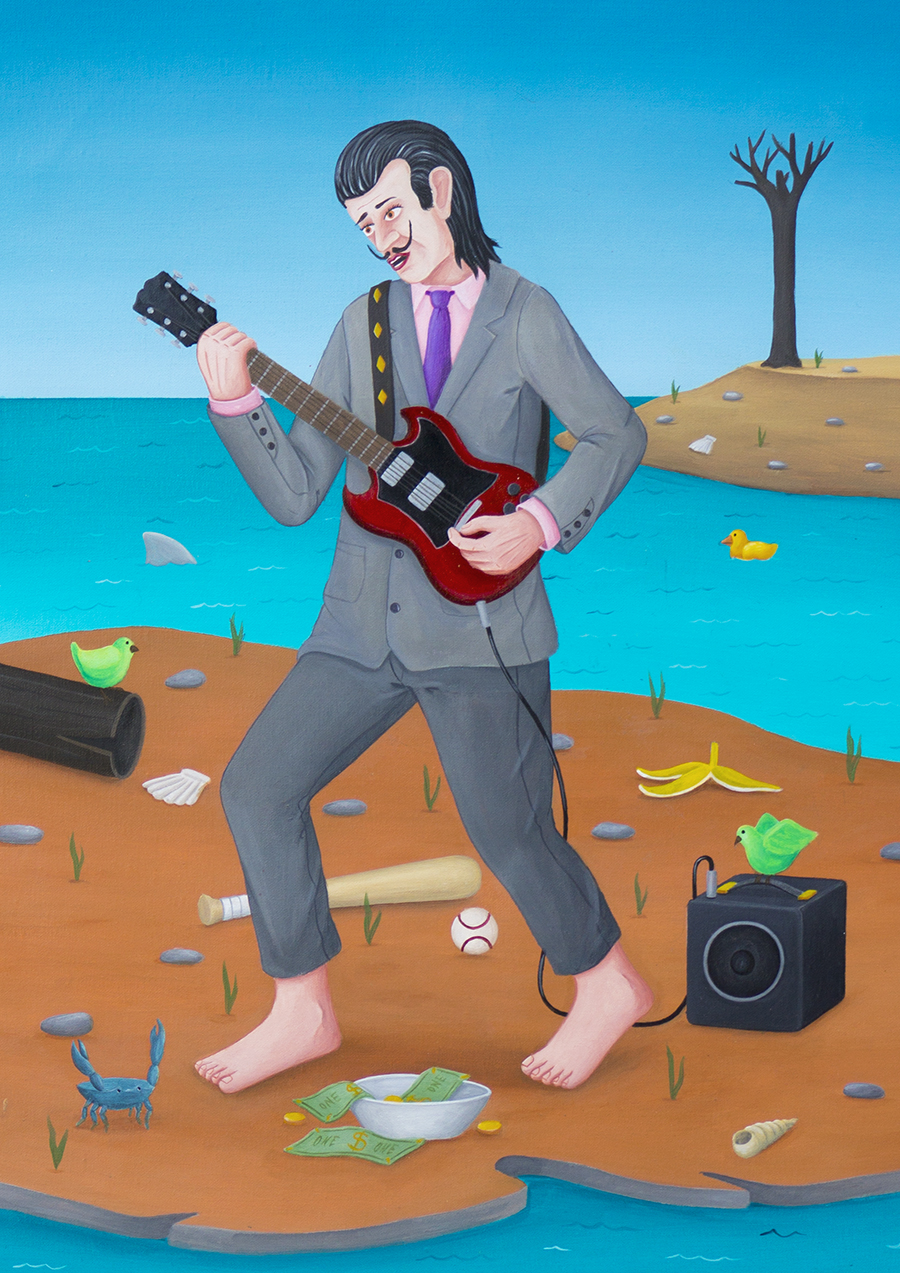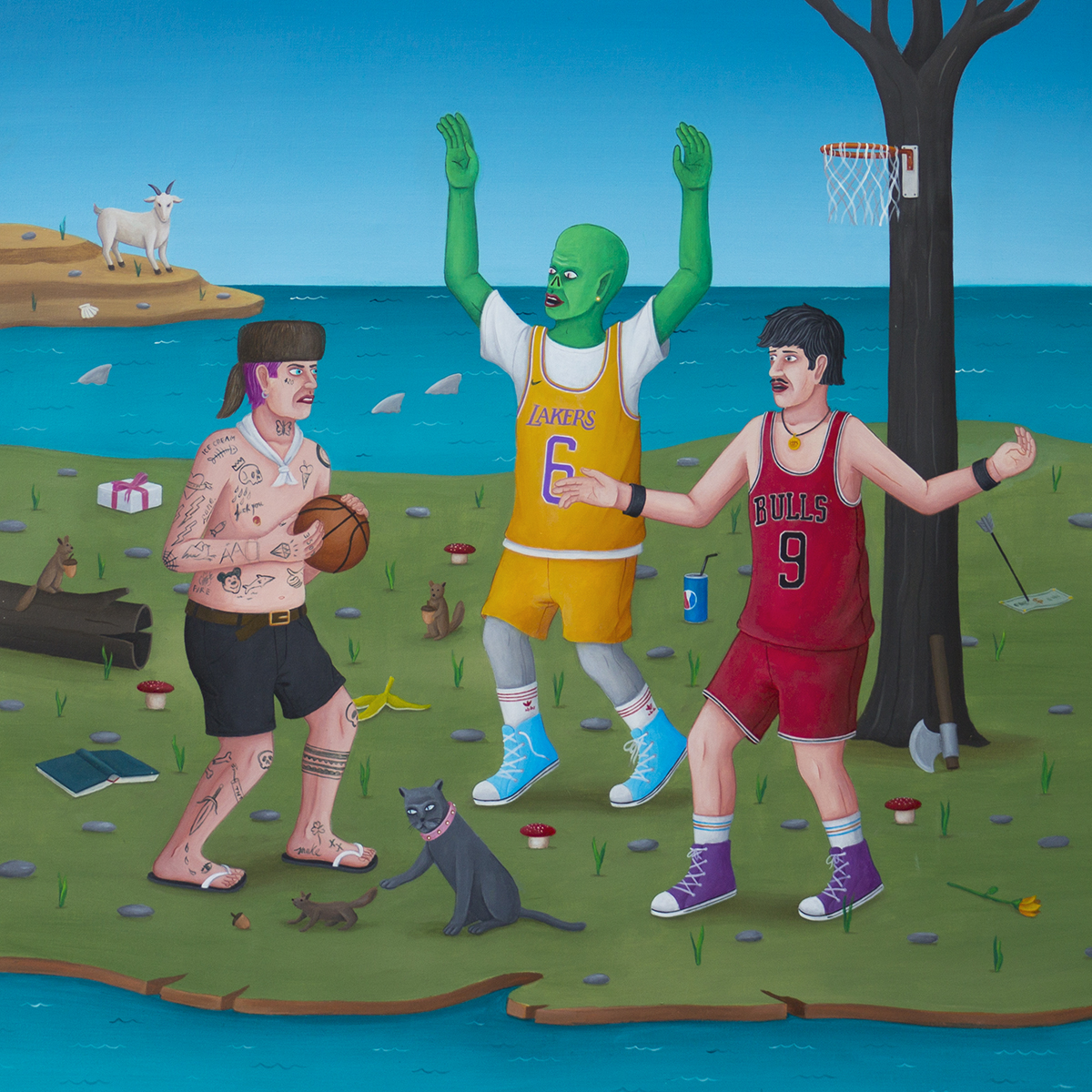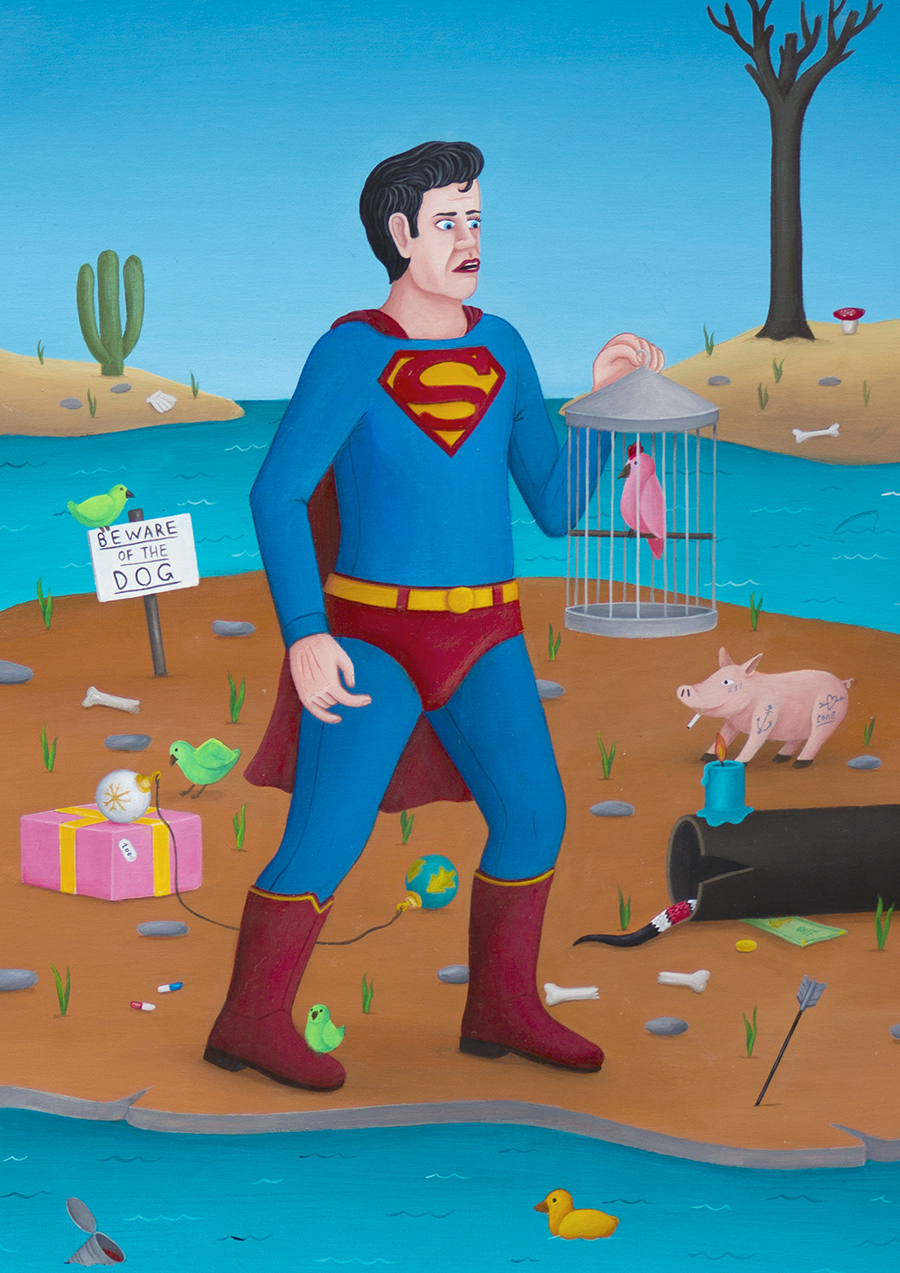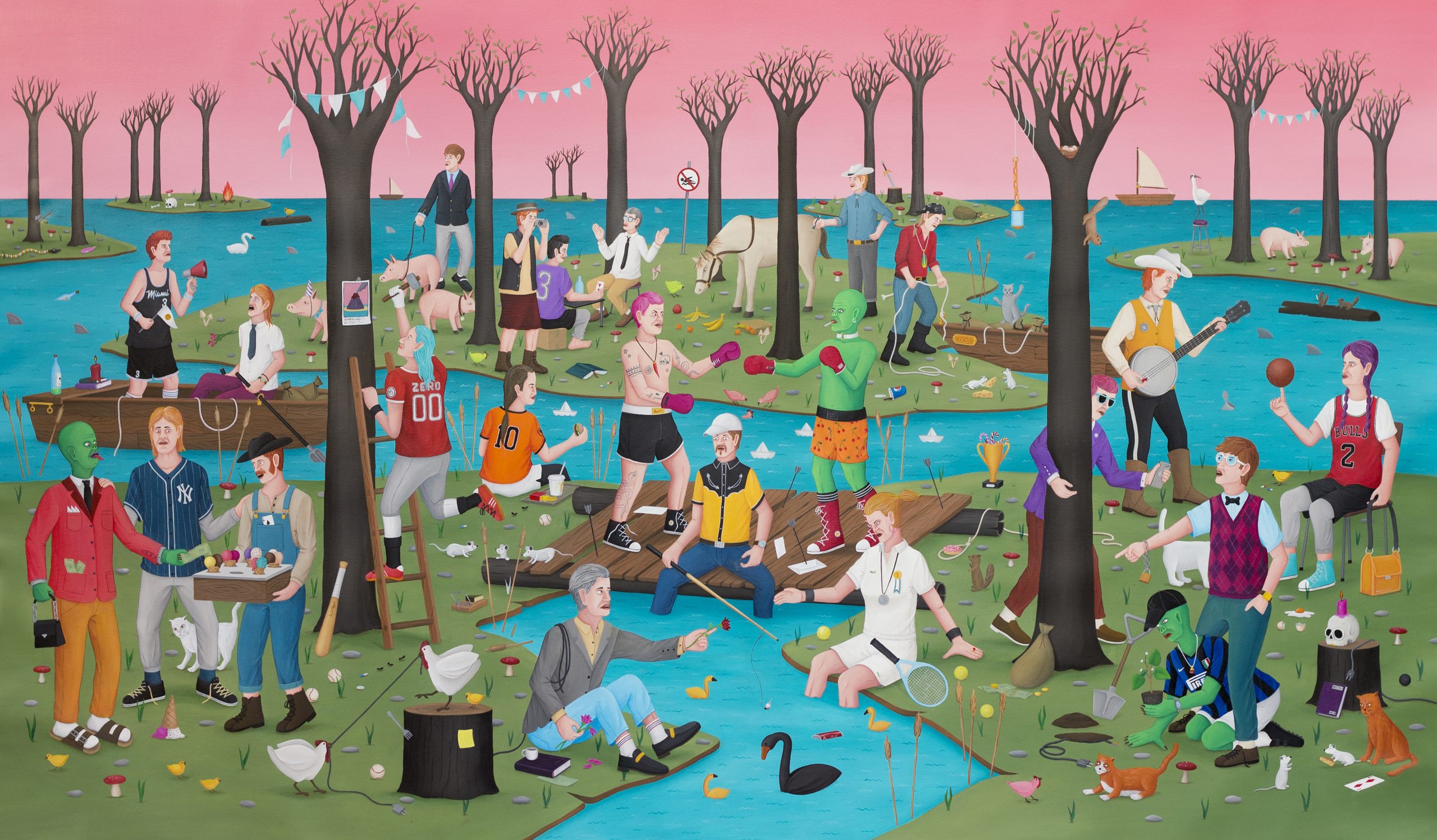Interview with Riccardo Nannini
24.02.2024
"Reality is not so different from the absurdities of my characters."
Reality it’s not different from the absurdities of my characters
The Italian artist Riccardo Nannini (Grosseto, 1980), also known as Cane, arrives this coming 18 January with his new proposal The Happy Islands.
Maintaining the interest in sociological complexity seen in his previous works, Nannini now decides to isolate the characters in small groups, thus creating micro-realities in which to question who they are.
Riccardo Nannini, El Reencuentro, 2023.
The island is undoubtedly a concept rich in symbolism and if anyone is the Robinson Crosoe of this rosy universe, it is Cane himself.
We chatted with the artist to find out first-hand what has been his own journey as an artist, his sources of inspiration, and why not, some answers about his extravagant aliens.
L- Let's talk a bit about your beginnings as an artist. In your work we find echoes of different disciplines such as comics, graffiti or digital art. What do you think your current style has adopted from each of them?
R-It's true that, in my beginnings, there were many influences from comics and DIY aesthetics and it's also true that I've made some incursions into urban art, but always returning to and without losing sight of what I've considered to be my main medium from the beginning, painting. In any case, the language of comics, being more accessible and less scripted, has helped me to introduce humour, which is very characteristic of my work, and also to develop a way of narrating that is still visible in these latest works.
L- I know you are currently working in Barcelona, what do you think of the reception of your work here? Is it very different from other places where you have been exhibited?
R- Actually, my artistic career began in Barcelona, so I've always been very conscious of the space that my proposal occupied in the city. That is to say, there are trends and styles that are better accepted in some places than in others; I know that my work has a lot of space in the USA, particularly in California, because historically that's where the bulk of the Lowbrow scene is developed and concentrated. In Europe and in Barcelona, this reception has been slow, but it seems that the market is finally opening up to these kinds of proposals.

![]()
Riccardo Nannini, Salvador Dalí Busker, 2023; Sergio Mora, Mercado Little Spain, New York, 2019.
L- Some of the references you've wanted to mention when talking about your work have been the Barcelona artists Sergio Mora and Joan Cornellà. Looking at your work, do you think you achieve a balance between the real and the utopian, or, like them, do you opt for pop surrealism?
A-Sergio Mora and Joan Cornellà are two artists I've been following closely for a long time, one because of the proximity of the scene and the other because of the affinity of language. I'm particularly interested in Cornellà's early works, in which there was still no text, because of the way he works on universal semiotics. And of Sergio Mora, how he broke the rejection of pop surrealism in Spain by fusing the aesthetics of the Californian hot rod with the most traditional folklore.
L-Let's move on to your more current self; your new series is entitled "Navegantes, náufragos e isleños" and it is precisely in these sunny terrains that you arrange your characters. They have a state of anger or exaltation that goes unnoticed at first glance. Part of the appeal of your work is that, although they may resemble the grotesque Bosch, your figures do not pray to God, but to money. A myriad of objects and luxury brands are conspicuously arranged in the scene. Explain to us what is behind this decision.
R-Money, objects, and brands do not have a meaning in themselves, that is to say, they are not necessarily protagonists in my narrative; but they are there, as they are in our everyday life. They are literally accessories that serve to fill the scene.
L- Another element that stands out above the rest is that, despite your intention to faithfully portray current events, more than one alien bursts onto the scene. What role does this character play? Is it related to the conspiracy wave we are experiencing?
R: In my work there has always been a strong autobiographical component, so that, inevitably, the whole narrative of my works was constructed from a single point of view - my own - and a single type of character - men-white-hetero-cis.
Therefore, when I became aware of this bias, I decided to introduce aliens as a way of representing otherness.

Riccardo Nannini, Amateur vs Profesional, 2023.
L-Now, there are several individual paintings that, on the other hand, do stick to the real world. Superman, Einstein, Elvis? Have you chosen to version them because of their role in visual culture, or have you chosen them because of a personal meaning that connects them ?
This question is courtesy of the author. Do the strange actions they perform have a hidden metaphor?
R-The first one I could think of is Superman with the bird, as it could allude to the mythical phrase "Is it a bird? Is it a plane?... It's Superman! "
Since my earliest works, I have played with "cameos" of famous and popular culture characters in my works, although I have always considered them as characters in disguise. In this particular series, their actions have no direct narrative intention, but some make the kind of connections you mention and that's fine, after all, it's the observer who ends up giving it meaning.
L- In addition to your rich figuration, the color chosen for the background also stands out on a compositional level: pink. Is this decision intended to underline your intention to alienate the satirical content of your paintings? Or do you consider that it belongs to your vibrant palette of colors?
R-At the beginning, as I said before, my aesthetic was very much influenced by underground comics, so black and white were predominant in my work. There was very little color and that created a certain distance from the viewer.
Pink and vibrant colors began, then, as a means of seduction. As in advertising, the aim was to create dreamlike scenarios that would attract and trap the viewer. And that effect has ended up trapping me too, so much so that I can't let go of them anymore.
L- If we continue with the plastic treatment, we find a great sense of flatness. This treatment of the volumes has a connection with the Californian Lowbrow scene of the 80s, which also pointed to the underground culture of the city. Do you think that the more caricatured drawing helps to dissect our nature? Do you feel reflected in the attitude and appearance of some of your characters?
R-Planism is part of my language as it derives from my training as a designer, so I've never worried about treating volumes in the same way as in classical painting. But I must also confess that, in reality, it is a technical deficiency, so, as they say, I have made a virtue out of necessity and I have learned to work with this limitation. I have learned to give it meaning and, consciously, I have made it a sign of distinction. In this sense, we can say that my works are things that resemble things, not that they want to imitate them, and this caricaturism helps to lighten the whole narrative of the work, as in a cartoon; even though they deal with serious subjects.

Riccardo Nannini, Superman and the bird, 2023.
L- Continuing with the structure of this interview, it's time to look to the future. Do you think you have already found the "Nannini" style that best expresses your concerns as an artist? Is there a technique or style that you want to implement in the future?
R-Every time I finish a series or a more or less big project, I always think that I have arrived at something, that is, at a technical or aesthetic level or a style that I am going to maintain for a while. However, as soon as I start working again, I realize that it is only a starting point toward new developments. Although, in any case, I do believe that, at this point, I have consolidated some aspects of my artistic discipline, not only on an aesthetic level but also on a conceptual, relational, or recognition level.
L- With the stark portrait that your paintings give us, do you intend to generate criticism or simply curiosity?
R- When my characters undertake actions, they are presented to us as idiotic, crazy, or absurd... in any case, out of the "normal". But what we assume as normality is only a convention and, many times, our reality is not so far from the absurdities that my characters commit. So, through a little touch of humor or a little disruption, I try to generate new connections, and new meanings, which are the first step towards new reflections. So, I guess it's a critical curiosity that I would like to generate.
L- Do you think that these attitudes, as sometimes happens with other cartoons such as the Simpsons, are an omen?
R- More than an omen, I consider them an oracle. I like to think that the actions of my characters are the result of chance, in the sense that I don't think rationally about what I'm going to paint, but that these actions and relationships arise automatically.
As it happens in the tarot cards, the various figures intertwine with each other by chance. And, since each of these figures represents an archetype, by relating them to each other, they give rise to an ancestral narrative that each one applies to his or her own experience. In the same way, we could say that my works act as narratives derived from archetypes that tell everyone a story that is intertwined with their own desires and experiences.
L-You must admit that nowadays it's complicated for people to observe and consume contemporary art, partly because of a prejudice about its complexity or elitism as complicated or banal. If you could make a future visitor leave with three ideas about your show, what would they be?
1-That art is not always something grandiloquent but can be everyday, fun, and light.
2-That things can be connected in other ways; they don't have to follow the linearity to which we are accustomed.
3-That, in the end, everything is a game.




